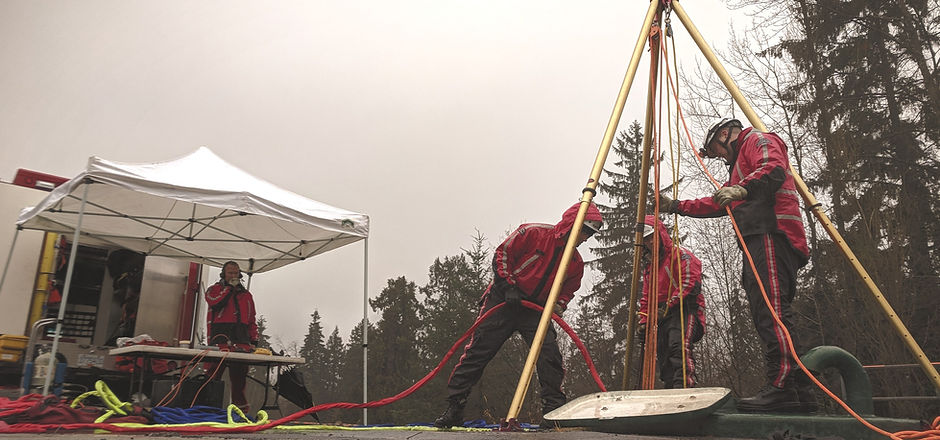
CONFINED SPACE TRAINING
NFPA AND INDUSTRY
Do you enter into Confined Spaces?
Are you aware of the hazards that exist with confined spaces?
Are you aware that confined spaces could have little or no oxygen? Or have explosive gasses inside? Or have other toxic chemicals inside? Or they may be absolutely fine.
Statistics show that 6 of 10 would be rescuers in confined space emergencies become victims themselves. How can you mitigate these risks?
Primarily by documentation and training.
Ronin Instructors not only teach confined space awareness, gas monitoring, supervisor and rescue courses; they are also required to work on our job sites as confined space rescue team leaders, and confined space attendants, conduct atmospheric monitoring and act as confined space responsible supervisors. The experience they gain on active sites allows them to ensure our students are receiving relevant information.
Our instructors work with local regulatory bodies to ensure they have the most up to date information on the legal requirements you will require to work in confined spaces safely. With our instructors backgrounds in adult education techniques, professional rescue and real world experience, students will learn what they need to know about confined spaces in a logical, easily understood manner.
CONFINED SPACE RESCUE AWARENESS
Duration: 8 Hours
Prerequisites: None
Confined Space Awareness is designed to prepare an individual to:
-
Identify types and classes of confined spaces
-
Understand local safe work regulations in regards to confined spaces
-
Utilize hazard recognition and mitigation techniques
-
Recognize incident hazards and initiate isolation procedures
Skills Taught:
-
Use atmospheric monitoring equipment
-
Use of ventilation equipment
-
Initiate an emergency response, including:
-
a search in areas immediately adjacent to the space
-
communication with victim(s)
-
performance of a non-entry rescue
CONFINED SPACE RESCUE OPERATIONS
Duration: 16 Hours
Prerequisites: Confined Space Awareness
Operations Level Confined Space Rescue is designed for entries that will be conducted in spaces with the following characteristics:
-
The internal configuration of the space is and unobstructed so retrieval systems can be utilized
-
The victim can be seen from the outside of the space’s primary access opening.
-
Rescuers can pass through the access/egress opening(s) with room to spare when PPE is worn
-
The space can accommodate two or more rescuers in addition to the victim.
-
Hazards in and around the confined space have been identified and can be mitigated
Skills Taught:
-
Utilize the incident command system and basic emergency scene management
-
Choose appropriate ventilation types and techniques
-
Choose and operate personal protective equipment
-
Understand team positions and responsibilities
-
Rig rescue systems for confined spaces
-
Understand tripod rigging and use
-
Build simple and compound mechanical advantage systems
-
Utilize rescue ropes and tie applicable knots
-
Package a patient for removal from a confined space
CONFINED SPACE RESCUE TECHNICIAN
Duration: 16 Hours
Prerequisites: Confined Space Operations
Technician Level Confined Space Rescue is designed for entries that will be conducted in spaces with the following characteristics:
-
The internal configuration of the space will not create entanglement hazards when using air lines.
-
The victim cannot be seen from the outside of the space’s primary access opening.
-
The portal size and configuration requires the use of a Supplied Air Respirator to allow a rescuer to pass through the access/egress opening(s)
Skills Taught:
-
Pre-plan a technician level confined space rescue
-
Use supplied air respirators and/or self contained breathing apparatus
-
Package patients for rescue in environments that will not allow for standard full body length packaging
TREAT THE RESCUER
Medical interventions on rope and in confined spaces.
This 5-day, 10+ hours per day seminar is designed for rescue and rope access technicians that want to increase their rescue skills. The first two days of the program are a full 16-hour International Trauma Life Support (ITLS Certificate) course, with rope rescue skill sets added. In the next three days of the program the students will take their medical and rope skills and apply them to practical scenarios on rope and in confined spaces.
Attendees will also learn techniques for improving their rescue skills while on rope.
Personal Gear Required:
-
Manufactured Class II or III harness
-
PPE: Helmet, Gloves, eyewear
-
Rugged, closed toe shoes
-
Long pants and weather dependent clothing
-
Water bottle
-
Descending system with Hands free DCD and backup device
-
Ascending system with 2 points of attachment
Courses are generally designed around 11mm rope equipment. Specific courses may include 12.5mm equipment on request.
Contact us if you have any questions about your skill level, equipment needs, or any other item you with to clarify.
